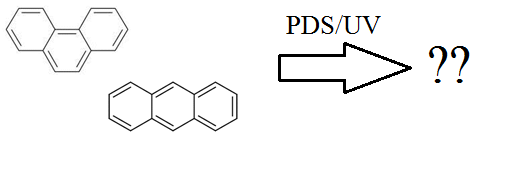
Anthracene and phenanthrene belong to a group of persistent environmental contaminants called PAHs. Evaluation of the structure of two selected PAHs i.e. anthracene and phenanthrene on their resistance to destruction by UV-activated PDS was the aim of this study. The authors focused on two aspects of this problem: - the role of the so-called ‘bay-region’, in the structure of phenanthrene, during PDS/UV oxidation - formation of substituted forms of these PAHs in the absence and presence of three nitrogen-containing compounds i.e. ammonia and nitrite or nitrate ions. Even though phenanthrene and anthracene have the same molecular formula, the difference in their ring assessment influences their degradability. Considering all the results, in all the cases anthracene was degraded faster and/or had a higher degradation rate. That proves phenanthrene to be more stable and resistant for degradation however comparison of PDS/UV systems vs. UV– irradiation alone confirms that the addition of PDS accelerates the degradation of anthracene and phenanthrene. Comparison of PDS/UV with the addition of three different nitrogen-containing compounds showed a significant difference between anthracene and phenanthrene. In the experiments with phenanthrene were observed additional peaks with an absorption maximum between 230-240 cm-1 which is characteristic of the nitro-group. Based on their absorption maximum and the addition of nitrogen-containing compounds, emerging by-products are assumed to be nitro-derivatives of phenanthrene. The results of GC/MS analysis suggest the possibility of formation of many compounds which can be formed from phenanthrene and are embedded on its skeleton. These analyzes also suggest the rearrangement of phenanthrene’s aromatic rings and formation new compounds.
Total file downloads: 3